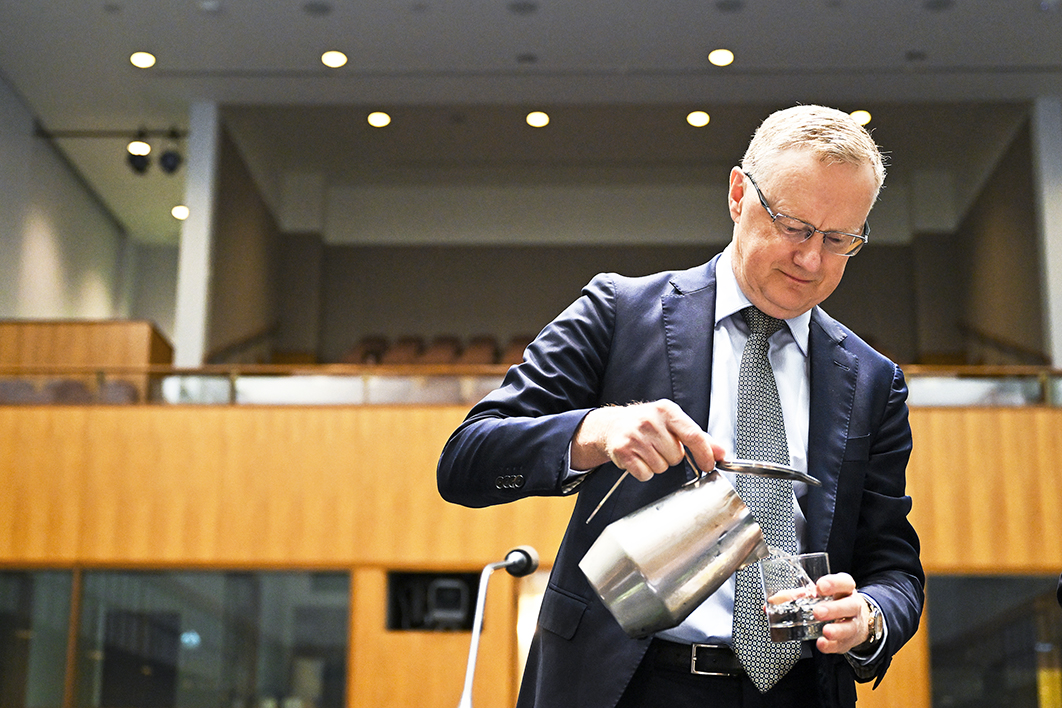In his short, lucid account of what he calls the “transformation” of the US Federal Reserve’s place in American society, The Fed Unbound, Columbia University’s Lev Menand traces the abrupt and immense enlargement of the role of central banks that began in 2007 and dramatically extended in 2020. It is a transformation as apparent in Australia as America, and as fundamental.
Menand’s account of contemporary central banking is not entirely convincing, and his remedies for its problems are specific to the United States and unlikely to be adopted. But in focusing on the change wrought in central banking by the global financial crisis and the pandemic he identifies the most important issue in central banking.
Compared with the implications and consequences of this change, many of the monetary policy issues we are debating today in Australia — issues now the subject of a government-initiated inquiry — are interesting but not fundamental. Should the Reserve Bank of Australia be charged with targeting a certain band of consumer price inflation, or some other band, or even a different measure of economic activity? Should more professional economists sit on the Reserve Bank board? Should interest rates have been even lower in the years before the pandemic? Should Reserve Bank governor Philip Lowe have been more ambiguous in his “forward guidance” on interest rates during the pandemic? All these are worthy questions, but no longer the main point.
For Menand — and his argument applies equally outside the United States — the main point is that in 2008 and (to a vastly greater extent) in 2020 central banks busted conventional expectations of what they could do, with consequences as yet unknown.
Menand, a former Fed official and a senior Treasury official in the Obama administration, brings to his task an understanding of financial structure and economics, law and history, as well as a clear and logical mind. He reminds us that the pandemic’s first economic effect was a global financial crunch. That crunch was so quickly quelled by the Fed and other central banks (including Australia’s) that we have almost forgotten the grave danger of financial collapse in March 2020. This was what triggered central bank intervention, though that support was soon extended much more widely during the pandemic.
Startled by the unknown consequences of the emerging pandemic, financial markets sold off assets. In just six weeks, US shares fell by nearly a third from their peak at the end of January 2020. Investors who had borrowed money to buy shares were forced to sell bonds and other financial assets to meet demands for cash repayments. Bond prices fell and interest rates rose, spooking markets that had expected to see the opposite happen. Suddenly everyone, remembering 2008, wanted cash rather than securities.
US primary dealers, who borrow cash to buy bonds, using the bonds as security, discovered lenders wanted their cash back. Already falling, bond prices fell more as dealers sold bonds to meet those cash calls. The panic spread rapidly through other financial markets in the United States and elsewhere.
Taught by the experience of 2008, the Fed responded by providing cash to the market and accepting bonds and other financial assets in return. Even compared with 2008, the Fed spent big: between September 2008 and the end of that year it acquired assets of US$1.3 trillion; from February to May 2020 it acquired US$2.9 trillion.
The central banks’ response to the pandemic came in two major phases, both of them extending the usual perimeter of their activity. The first phase aimed to stop an immediate financial panic by sharply lowering interest rates and lending cheap money to financial businesses that needed it. The second phase aimed to support household and business demand through the long pandemic in two ways: directly, by keeping interest rates very low and freely lending money to banks and then to a wider category of businesses that needed it; indirectly, by buying government bonds issued to finance deficit spending.
Whereas the cash splurge from the Fed peaked at not much more than US$1.3 trillion during the global financial crisis, by February 2022 it had spent close to another $2 trillion. Its assets were now nearly four times bigger than at their peak in 2008.
In Australia, where shares fell just as sharply (and by a little more) in early 2020, the Reserve Bank spent much more as a share of GDP. In the second week of March 2020 it held $89 billion in Australian dollar assets. By the fourth week of May that amount had more than doubled to A$200 billion as the bank grappled with similar issues of financial instability and also began supporting fiscal policy by purchasing Australian government bonds. At the peak, in March 2022, the Reserve Bank would own more than six times the value of Australian dollar assets it held at the beginning of the pandemic, a total of well over half a trillion dollars.
This enlargement of the role of central banks matters to Menand for reasons that don’t necessarily matter to us in Australia. He is bothered because the US Federal Reserve is doing things Congress didn’t intend when it set up the federal reserve system. In this respect, he is taking an “originalist” approach. Congress is supposed to control tax and spending, yet the Fed is commanding resources by issuing money without congressional authorisation.
Menand wants Congress to be more active in responding to crises. That would be more democratic, he says, and also more egalitarian. Interest rate cuts stimulate increases in asset prices, helping rich people. Government spending, by contrast, can be targeted in a fairer way to support demand.
All of that is true, but a financial crisis doesn’t wait around while parliaments debate the proper response. Nor is the role of central banks in creating money to buy bonds during downturns necessarily inegalitarian. In principle, bond purchases facilitate government spending, with the character of that spending determining its distributive effect.
The legal remit of the central bank concerns us less in Australia because the federal government has the authority (never used, but there) to instruct the Reserve Bank to pursue, or not pursue, specified policies. Moreover, the Treasury secretary sits on the bank’s board and could convey a government view if he or she chose to do so, and by convention the governor of the bank and the treasurer of the day make a point of staying in close touch. Legally, the Reserve Bank is closer to being the monetary policy arm of government than its US counterpart. Its independence is conferred upon it, not required.
Had the Reserve Bank refused to buy bonds during the pandemic in the same way its predecessor, the then Commonwealth Bank, refused to finance deficit spending by the Scullin government beyond a certain point during the Great Depression, the consequences would have been fascinating. Central bank thinking has moved on and the issue didn’t arise. So has the legislative framework for central banking, partly reflecting Labor treasurer Ben Chifley’s determination in 1945 to prevent the central bank acting as it did during the Depression.
Menand rightly blames the shadow banking sector for the US financial crises of 2007–08 and early 2020. These institutions borrow cash to buy higher-yielding securities, or lend money with limited supervision and without a government guarantee for depositors. In the run-up to the 2007–08 crisis, investment banks like Bear Stearns and Lehman Brothers were borrowing in the overnight money market to buy home mortgage securities and other higher-yielding assets. When the crisis made the value of these home mortgage securities difficult to determine and hard to sell, overnight lenders wanted their money repaid rather than allowing it be rolled over. The Fed was forced to support these shadow banks by lending them cash and acquiring mortgage securities, but not before Lehman went down and plunged American and European financial markets into years of grief.
Australia’s financial crises in 2008 and 2020 were quite different. Shadow banks play a much smaller role in the bank-dominated Australian financial market (though in 2009 the Reserve Bank and the government found they had to support the market for bundled or securitised home mortgages and prop up lenders in the car loan market).
The Reserve Bank’s big job in 2008–09 was to protect Australian banks when, at the height of the crisis, they were no longer able to roll over their substantial US dollar-denominated loans from offshore institutions. The bank provided liquidity, including in US dollars. When other central banks guaranteed domestic bank deposits and other borrowing, the Reserve Bank was obliged to follow suit.
Though the circumstances were different in each country, the 2008 crisis greatly extended the scope of central bank actions. When a similar flight to cash began in February 2020, central banks knew what to do.
The central bank’s response to these two crises has left us with questions we are yet to work through. For example: the Reserve Bank of Australia now owns more than a third of the net debt of the Australian government. It is paid interest on that debt, amounting to something in the order $3 billion a year. As it retires its Australian government debt holding, the federal government will need to sell additional bonds to the private market (or increase taxes — not a live option) to finance its repayments.
Over time, the government will need to repay more than $200 billion (by redeeming bonds) to return the bank’s balance sheet holding of official debt to its pre-Covid size. That will mean higher interest rates than otherwise, higher taxes than otherwise, and less spending than otherwise on other things like nuclear submarines or disability support. How much of that $3 billion or so in interest payments should the Reserve Bank return to the government as profit on central banking operations? Even at the most ordinary of times, that question opens up a tense conversation.
And given that the bank bought those bonds with cash it created out of nothing but expects to be repaid out of taxpayers’ pockets or by the issuing of additional bonds to the private market, will governments begin to find the obligation inconvenient and seek to negotiate their way out of it? Will they ask why the bank needs — and what it will do with — all the cash it gets from government in return for its bonds? Treasury might find itself discouraging the bank from running down its bond inventory, or even encouraging the bank to add to it.
In tough times, these possibilities will all come to mind. The Reserve Bank is, after all, another arm of government, another agency of the Crown. Central banks can destroy as well as create money so the Reserve Bank could choose to extinguish payments from Treasury, at the same time extinguishing the corresponding accounting liability. But to extinguish payment from taxpayers looks odd.
The bank might well argue that it will need the cash from the redeemed bonds to buy bonds during the next downturn. Cash would then move from the Treasury to the Reserve Bank in good times, and from the Reserve Bank back to Treasury in bad times, confirming the bank’s new role as a participant in fiscal policy.
If the next downturn is far enough away, that might be a useful and workable reimagining of fiscal and monetary policy. The bank would assume a responsibility for fiscal stabilisation while the Treasury assumes a responsibility for economic stabilisation, the opposite of their declaratory roles in past decades. If it was to work, however, it would need to be discussed and agreed and publicly known, all of which is unlikely.
That issue is one aspect of the changed relationship between fiscal and monetary policy consequent on the changed role of the central bank. For decades, economic policy in Australia has been run on the official understanding that the Reserve Bank would smooth the ups and downs of the economy using interest rates while the government’s budget would be designed to achieve balance “in the medium term.”
During the pandemic Treasury secretary Steven Kennedy pointed out that the Reserve Bank cash rate was near zero, the effective limit of what the bank could do to stimulate demand using interest rates. While the government had spent a vast amount in pandemic support, Kennedy suggested, it could certainly spend a great deal more if necessary. The implication is that fiscal policy could become the active arm of economic stabilisation while the Reserve Bank slowly recovered its interest rate flexibility.
In the event, recovery from the pandemic was stronger than expected, and fiscal and monetary policy have been tightening at the same time. Whether or not fiscal policy emerges as the preferred stabilisation tool, a transfer of the focus of day-to-day economic policy from the Reserve Bank in Sydney back to the Treasury in Canberra waits on the character and timing of the next big downturn. •
The Fed Unbound: Central Banking in a Time of Crisis
By Lev Menand | Columbia Global Reports | US$16 | 176 pages




